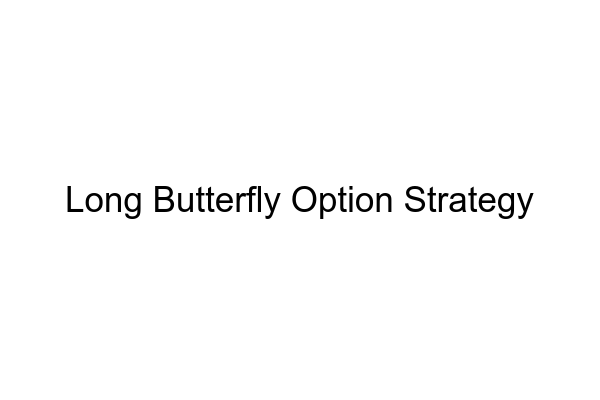Long Butterfly Option Strategy

What are the characteristics of this option strategy?
The Long Butterfly Option Strategy is a low-risk, limited profit option strategy where a trader buys 1 ITM Call, sell 2 ATM Call and buy 1 OTM Call of the same underlying asset and same expiration date. The trader will only profit if the underlying asset stays in a relatively narrow price range. If the asset moves outside of that range, the maximum possible profit is lost.
Is this a bullish, bearish or neutral strategy?
This strategy is a neutral strategy. The trader is not necessarily bullish or bearish on the underlying asset. The risky part of this strategy comes due to theta decay (time decay). If the underlying asset is within the specified price range and the trader is long, the strategy will be profitable.
Is this a beginner or an advanced option strategy?
The Long Butterfly Option Strategy is considered an intermediate level option strategy. It can be used by experienced traders and beginners to manage risk and help protect profits.
In what situation will I use this strategy?
The Long Butterfly Option Strategy is usually used to take advantage of the high probability of a stock price staying in a narrow range when implied volatility is low. This strategy can be used if the trader is expecting a rise in the stock, but believes that the stock won’t rise too much (or fall too much).
Where does this strategy typically fall in the range of risk-reward and probability of profit?
The risk-reward of this strategy is usually neither substantially large nor small. The maximum loss for this strategy is the total premium paid for the options, which is the maximum risk taken. The maximum potential reward is the difference between the strikes minus the net premium paid, which is the maximum reward taken. The probability of profit is typically high, but not guaranteed.
How is this strategy affected by the greeks?
The Greeks play an important role in the Long Butterfly Option Strategy. Theta (time decay) and Vega (volatility) especially, have an impact on the profitability of the trade. If time decay and volatility are high, the strategy may become unprofitable even if the underlying asset stays within the chosen price range.
In what volatility regime (i.e VIX level) would this strategy be optimal?
The Long Butterfly Option Strategy is usually most profitable in a low implied volatility environment. Therefore, the VIX level should be low for this strategy to be optimal.
How do I adjust this strategy when the trade goes against me? And how easy or difficult is this strategy to adjust?
Adjusting the Long Butterfly Option Strategy when the trade goes against you can be a bit tricky. Traders may decide to either “roll” the position (close the current trade and open a new one) or “hedge” part of the position to reduce risk. The complexity of the adjustment depends on the trader’s level of experience and risk appetite.
Where does this strategy typically fall in the range of commissions and fees?
The Long Butterfly Option Strategy usually occurs on extremely low commission and fee structures due to its low risk nature. In addition, the strategy can be constructed with a net debit or net credit, both of which reduce commissions and fees even further.
Is this a good option income strategy?
The Long Butterfly Option Strategy can be used as an income strategy, although it may not be the most profitable way to generate income. The strategy mostly relies on time decay, hence the income generated may not be substantial.
How do I know when to exit this strategy?
When trading the Long Butterfly Option Strategy, the trader should exit the trade when the underlying asset reaches either one of the strike prices. The trader should also exit the trade if they get close to the maximum loss they are comfortable with, or if they reach the maximum potential reward.
How will market makers respond to this trade being opened?
Market makers typically respond to this trade by wideni
ng the bid-ask spread and charging higher than usual commissions and fees. This is due to the fact that market makers can take the other side of the trade, meaning they will be at risk.
What is an example (with calculations) of this strategy?
For example, if a trader believes that a stock will not move much in the near term, they can enter a Long Butterfly Option Strategy by buying one ITM call option at a strike of 42, sell two ATM call option at a strike of 45, and buy one OTM call option at a strike of 47. Let’s assume that the options has a time to expiration of 30 days, and are currently trading at a total premium of $2.00. If the stock price stays between 42 and 45, the trader will make a maximum profit of $3.00 (the difference between the strikes, 45-42, minus the net premium paid, 2.00). However, if the stock moves outside of this range, the potential profit will be lost.
MarketXLS
MarketXLS is an Excel add-in that provides live, streaming stock quotes and financial news directly in Excel without needing additional software. With MarketXLS, traders can construct more sophisticated option strategies such as the Long Butterfly Option Strategy in a very intuitive way. The add-in also makes it easy to analyze and understand the market, helping traders make better decisions.
Here are some templates that you can use to create your own models
Long Butterfly with Calls Option Strategy
Long Butterfly with Puts Option Strategy
Iron Butterfly Option Strategy
Short Butterfly Spread
Butterfly for Shorts Spread
Search for all Templates here: https://marketxls.com/templates/
Relevant blogs that you can read to learn more about the topic
Options Trading (Strategies)
2 Leg Option Strategies
Maximizing Profits with a Bull Put Spread Strategy
Long Butterfly Spread With Puts (Using Excel Template)
5 Successful Options Strategies Using The Most Liquid Options
